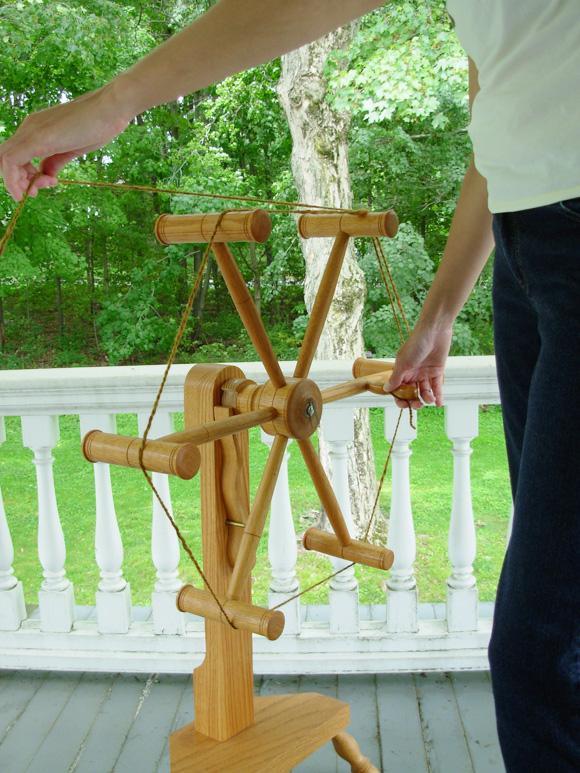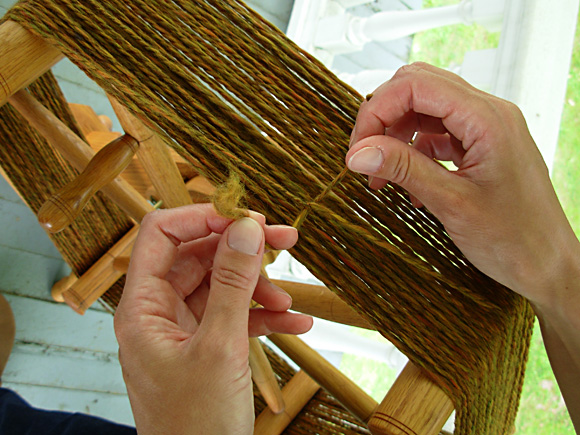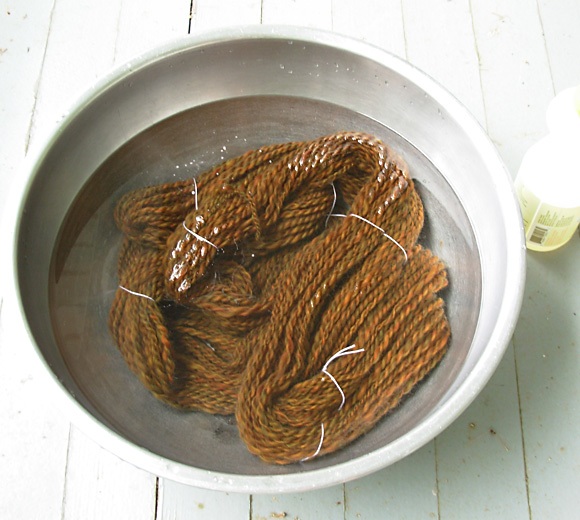
 |
|
|
| by Lee Juvan |
|
You’ve done it; you’ve filled a bobbin or spindle
with your handspun yarn! But to paraphrase Yogi Berra: it ain’t
finished till it’s finished. Like a knitted or newly sewn
garment that isn’t done until it has been washed and blocked,
newly spun yarn needs to be washed or steamed to set the twist.
Some spinners may like to use freshly spun yarn as is (perhaps
those who like to work with “energized” yarns full
of active twist or those planning to weave with their handspun
and finish it as cloth), but most knitters will find that yarns
behave better and more predictably if we take a few more steps
before using our handpsun. Woolen yarns, especially down breeds,
can change rather dramatically after finishing—plumping
up and changing gauge from their unwashed counterparts. |
|
Those who spin often will find a niddy-noddy or reel to be a worthwhile investment. It’s easier to show someone how to use a niddy-noddy than it is to explain it. Keep your tension
even (don’t pull too hard) and keep moving in one direction.

If you have used an alternative (like your arm), you’ll need to measure the length of one full wrap to estimate your yardage. Every once in a while I get lucky, and the last bit of yarn reaches the beginning of the skein as I am winding it, but most of the time, I need to bridge the gap with a bit of scrap yarn. 
Once you’ve wound all the yarn from your spindle or bobbin, you’ll need to secure the skein with a figure-eight tie in three to five places to prevent it from becoming tangled as you wash or dye it (go with 5 places if your yarn is very fine or if you will be dyeing it after winding). I like to use white crochet cotton for my ties, which is easy to see when it comes time to cut it off.
Washing or Steaming Your Yarn to Set
the Twist To steam your yarn, hold it with a pair of tongs or a chopstick or leave it on the niddy-noddy and carefully move the yarn through the steam coming out of a teakettle--or use a garment steamer if you have one. Wear an oven mitt and watch your body parts--steam burns! Allow the yarn to dry for a few minutes before using it. Be aware that steaming a yarn on a niddy-noddy is the equivalent of drying it under tension; your gauge may change after the item is washed, so it’s best to wash a swatch first. Steaming is quick and allows you to begin using your yarn more quickly. It works for all fibers, and if your yarn is already clean (without spinning oils or dust or dirt), it’s a fast way to set the twist. Although steaming is quick, I usually like to wash my skeins when I’m done spinning so they feel thoroughly clean and ready for knitting.
On the other hand, sometimes your yarn may like it rough--you may actually want to full or felt your yarn slightly during the finishing stage. You might want to use this finishing technique with bulky singles, for example, to discourage them from pilling. In that case, check out the helpful directions for fulling your handspun in Amy King’s Spin Control or in Judith MacKenzie’s The Intentional Spinner. I am especially careful about what I use to wash silk. Silk prefers an acidic environment and dish soap and laundry detergents can be detrimental to its fibers. I’ve used pure castile soap (Dr. Bronner’s), Eucalan and SOAK for washing handspun silk yarns; Michael Cook, an experienced worm shepherd, recommends Orvus paste. Plant fibers such as linen and cotton are best finished by simmering the skeins in dish detergent in a pot of water on the stove for 40 minutes or more. If you plan to dye cotton yarn, you’ll need to simmer it in a pot of water and detergent to which you’ve added two tablespoons of washing soda (also called soda ash) to remove the natural waxes that will prevent even dye absorption. Because I knit with my linen and cotton yarns, they are plied and I boil them in skein form (tied in several places to prevent tangling); those who are finishing linen or cotton singles for weaving may want to boil them on plastic cores (see Olive and Harry Linder’s classic books, Handspinning Cotton and Handspinning Flax, for more information on making your own boiling bobbins or try Stephanie Gaustad’s wonderful new video, Spinning Cotton). Remove your clean skein from the rinse water, gently squeeze out any excess water, and lay the skein flat on a towel. Roll the towel up and press out as much remaining moisture as you can. I hang my skeins to dry without tension because I generally knit with my handspun and prefer to retain any natural elasticity. If you want your skeins to dry with a weight, try Maggie Casey’s clever trick of hanging a plant mister on the bottom loop. Twisting Your Skein
|
| ABOUT THE AUTHOR |
 You can see more of her work on Ravelry, including her new line of historically inspired patterns. |
| Text © 2010 Lee Juvan; Images © 2011 Lee and Tom Juvan. Contact Lee |